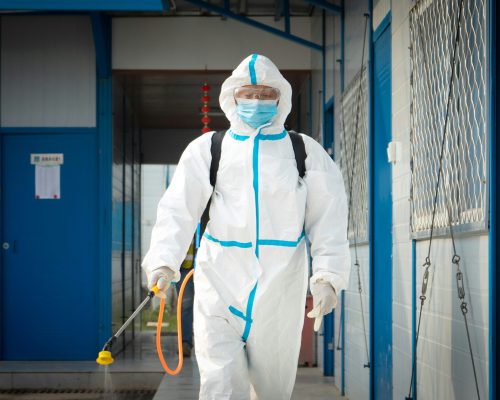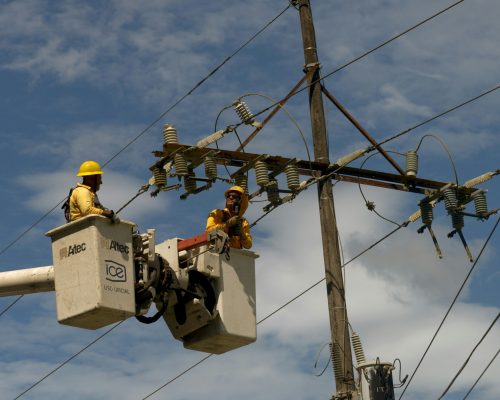1. Diploma in Industrial Safety
Awareness Courses
1. Respirable Silica

★ Objective:
Educate workers and employers about the health hazards associated with respirable crystalline silica exposure, and promote safe practices to minimize risk.
★ Duration:
Available as an online module or blended learning experience.
★ Prerequisites:
Prior experience in safety roles or completion of basic safety courses is recommended.
➤ Key Topics Covered:
◆ Understanding Silica and Its Workplace Presence
◆ Health Effects and Long-Term Exposure Risks
◆ Creating and Maintaining a Safe Work Environment
◆ Employer and Employee Roles in Silica Safety
2. Manual Material Handling
★ Objective:
Equip workers with practical skills to prevent injuries during manual material handling tasks through safe lifting techniques, proper carrying methods, and ergonomic best practices.
★ Duration:
Available as an online module or blended learning experience.
★ Prerequisites:
Recommended for individuals with prior safety training or experience in workplace safety roles.
Key Points Covered:
🔹 Introduction to safe manual handling practices
🔹 Identify common workplace injury risk factors
🔹 Conduct proper pre-task risk assessments
🔹 Learn correct lifting and carrying techniques
🔹 Apply long-term injury prevention strategies

3.Respiratory Protection

★ Objective:
Provide essential guidance on selecting, using, and maintaining respiratory protection to ensure workplace safety and compliance.
★ Duration:
Available as an online module or blended learning experience.
★ Prerequisites:
No prior qualifications required
Key Points Covered:
🔹 Recognize respiratory hazards in the workplace
🔹 Identify types of respirators and applications
🔹 Follow proper respirator fit testing procedures
🔹 Practice donning and doffing respirator safely
🔹 Inspect and replace filters and cartridges
🔹 Perform cleaning and safe respirator storage
4.Overhead Crane Safety
★ Objective:
Teach safe practices for operating or working near overhead cranes, focusing on hazard identification, equipment inspections, proper hand signals, and safe lifting techniques.
★ Duration:
Available as an online module or blended learning experience.
★ Prerequisites:
No prior qualifications required
Key Points Covered:
🔹 Identify different types of overhead cranes
🔹 Conduct daily pre-use crane safety inspections
🔹 Recognize common mechanical failures and risks
🔹 Understand hand signals and safe communication
🔹 Maintain compliance with crane safety regulations

5. Transportation of Dangerous Goods (TDG)

★ Objective:
Align with the 2025 TDG (Transportation of Dangerous Goods) amendments by training participants to identify and classify dangerous goods, apply correct labeling, manage documentation, and follow safe handling and emergency response procedures.
★ Duration:
Available as an online module or blended learning experience.
★ Prerequisites:
No prior qualifications required
Key Points Covered:
🔹 Learn TDG regulations and compliance standards
🔹 Identify and classify dangerous goods properly
🔹 Apply packaging, labeling, and documentation rules
🔹 Follow safe handling and transport procedures
🔹 Respond effectively to emergencies and spills
🔹 Understand exemptions and cross-border situations
6. Asbestos and Silica Dust Hazards Training
★ Objective:
Equip workers with essential knowledge and protective strategies to safely handle and work around asbestos fibres and silica dust, minimizing long-term health risks.
★ Duration:
Available as an online module or blended learning experience.
★ Prerequisites:
No prior qualifications required
Key Points Covered:
🔹 Understand what asbestos and silica dust are
🔹 Compare and identify health hazards of both
🔹 Create and maintain safer work environments
🔹 Recognize employee and employer safety responsibilities

7. Bloodborne Pathogens Training

★ Objective:
Educate participants on the risks, transmission methods, and prevention strategies for bloodborne pathogens in the workplace, including safe handling practices and use of PPE.
★ Duration:
Available as an online module or blended learning experience.
★ Prerequisites:
No prior qualifications required
Key Points Covered:
🔹 Understand fundamentals of bloodborne pathogens safety
🔹 Learn how pathogens transmit in workplaces
🔹 Apply exposure prevention and control strategies
🔹 Handle sharps and biohazardous materials carefully
🔹 Follow correct emergency response after exposure
8. Food Handling Safety
★ Objective:
Train food handlers to recognize contamination hazards and apply safe work practices, hygiene standards, and temperature controls to prevent foodborne illnesses.
★ Duration:
Available as an online module or blended learning experience.
★ Prerequisites:
No prior qualifications required
Key Points Covered:
🔹 Identify sources of foodborne illness transmission
🔹 Practice personal hygiene during food handling
🔹 Wash hands using proper sanitizing methods
🔹 Clean and sanitize kitchen surfaces correctly
🔹 Prevent food cross-contamination at all stages
🔹 Control and monitor safe food temperatures

9. Hazard Analysis and Critical Control Points (HACCP)

★ Objective:
Introduce participants to the internationally recognized HACCP system, equipping them to identify food safety hazards, establish Critical Control Points (CCPs), and implement effective monitoring and corrective actions.
★ Duration:
Available as an online module or blended learning experience.
★ Prerequisites:
No prior qualifications required
Key Points Covered:
🔹 Learn history and background of HACCP system
🔹 Develop and implement HACCP safety plans
🔹 Identify hazards and define critical limits
🔹 Monitor processes and record safety data
🔹 Apply corrective actions and verification methods
10. Defensive Driving

★ Objective:
Promote safe driving habits by enhancing awareness, attitude, and decision-making skills to reduce risks and prevent accidents on the road.
★ Duration:
Available as an online module or blended learning experience.
★ Prerequisites:
No prior qualifications required
Key Points Covered:
🔹 Learn fundamentals of defensive driving skills
🔹 Conduct vehicle safety checks and maintenance
🔹 Recognize risks from distracted driving habits
🔹 Apply defensive driving and collision avoidance
🔹 Prepare for safe winter driving conditions
11. Ladder Safety and Worker Safety

★ Objective:
Provide essential knowledge on safe ladder selection, inspection, and proper usage to prevent workplace falls and injuries.
★ Duration:
Available as an online module or blended learning experience.
★ Prerequisites:
General workplace safety awareness is recommended.
Key Points Covered:
Understand various ladder types and their specific applications
Learn OSHA and CSA standards for ladder safety compliance
Conduct thorough ladder inspections before every use
Recognize hazards while setting up or using ladders
Apply safe climbing, carrying, and positioning techniques
Follow rules for job-made and specialty ladders usage
12. Fall Protection
★ Objective:
Train workers to recognize fall hazards and correctly use fall protection equipment to reduce risks and ensure compliance with safety standards.
★ Duration:
Available as an online module or blended training program.
★ Prerequisites:
General workplace safety knowledge is recommended.
Key Points Covered:
Identify common workplace fall hazards and unsafe conditions
Learn types of fall protection systems and their applications
Use anchors, lanyards, and full-body harnesses safely
Select connecting devices and shock absorbers appropriately
Inspect and maintain fall protection equipment regularly
Develop fall protection and emergency rescue plans effectively

13. Lockout Tagout in the Workplace

★ Objective:
Ensure workers understand procedures for controlling hazardous energy during equipment servicing and maintenance to prevent accidental startup and injuries.
★ Duration:
Available as an online module or blended learning course.
★ Prerequisites:
Basic industrial safety awareness is recommended.
Key Points Covered:
Learn duties of authorized, affected, and other employees
Understand OSHA requirements and company responsibilities clearly
Identify common electrical, hydraulic, and pneumatic hazards
Apply proper lockout and tagout devices on equipment
Follow the seven key steps of energy isolation process
Develop and maintain a compliant lockout/tagout program
14. Basic Electrical Safety Awareness
★ Objective:
Provide a foundational understanding of electrical hazards and safe work practices to help prevent accidents and ensure workplace safety.
★ Duration:
Available as an online module or blended training session.
★ Prerequisites:
None required; suitable for all employees.
Key Points Covered:
Understand dangers of electricity in workplace environments
Review CSA Z462 and NFPA 70E safety standards
Recognize effects of electrical current on human body
Learn importance of approach boundaries and safe distances
Identify common unsafe practices around electrical systems

15. Electrical Safety for the Non-Electrical Worker

★ Objective:
Train non-electrical employees to recognize and avoid electrical hazards in the workplace, promoting safer environments and reducing risk.
★ Duration:
Available as an online module or blended training program.
★ Prerequisites:
No electrical trade background required.
Key Points Covered:
Recognize common workplace electrical hazards and exposures
Understand CSA Z462 and NFPA 70E compliance requirements
Learn safe behavior for employees working near electricity
Recognize arc flash and electric shock risk factors
Gain continuing education credits through this training
16. Electrical Risk Assessment
★ Objective:
Teach structured methods to identify, evaluate, and reduce electrical risks in the workplace through proactive safety planning and hazard control.
★ Duration:
Available as an online module or blended training session.
★ Prerequisites:
Basic workplace safety knowledge is helpful.
Key Points Covered:
Learn processes for hazard identification and assessment
Understand regulatory requirements for electrical risk evaluation
Conduct detailed initial risk estimation in work areas
Develop strategies to reduce and control identified risks
Maintain proper records of risk assessments and findings

17. Arc Flash Hazard Awareness

★ Objective:
Build awareness of arc flash hazards and equip participants with protective safety measures to prevent electrical injuries in the workplace.
★ Duration:
Available as an online module or blended training course.
★ Prerequisites:
Basic workplace safety training is recommended.
Key Points Covered:
Understand what an arc flash is and why it happens
Identify contributing factors that increase arc flash severity
Learn harmful effects of arc flash on workers’ health
Apply protective measures using PPE and safe practices
Understand equipment labeling and arc flash boundary standards
Learn approach distances and categories of arc flash hazards
18. Electrocution Hazards in Construction
★ Objective:
Educate construction workers on electrical hazards and safe practices to prevent electrocution and ensure a safer job site.
★ Duration:
Available as an online module or blended training program.
★ Prerequisites:
General safety awareness is recommended.
Key Points Covered:
Identify common electrical hazards on construction job sites
Understand OSHA regulations and compliance requirements clearly
Recognize dangers of overhead and underground power lines
Learn safe handling of cords, cables, and portable tools
Apply grounding and continuity procedures to equipment
Know employer responsibilities for worker safety and training

19.Crane and Hoist Hand Signals

★ Objective:
Teach workers standardized hand signals to safely guide crane and hoist operations, ensuring clear communication and accident prevention.
★ Duration:
Available as an online module or blended training session.
★ Prerequisites:
None required; open to all applicants.
Key Points Covered:
Learn internationally recognized crane and hoist hand signals
Understand duties and responsibilities of the signal person
Apply correct communication methods to prevent accidents
20. Machine Guarding
★ Objective:
Ensure workers understand the safe use of machinery equipped with proper guarding systems to prevent injuries and maintain compliance with safety standards.
★ Duration:
Available as an online module or blended training format.
★ Prerequisites:
None required; suitable for all workers.
Key Points Covered:
Understand importance of machine guarding for worker safety
Learn major hazards from unguarded or poorly maintained machines
Review workplace accident cases related to missing guards
Apply best practices for using safety guards and barriers


